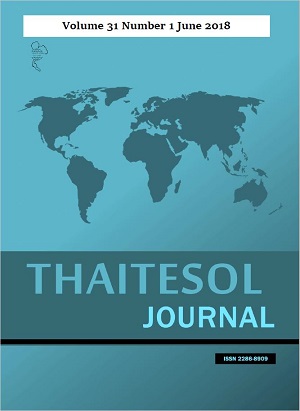Creating powerful, international learning environments in higher education: A case study of an English-language university department in Japan
Main Article Content
Abstract
This paper discusses the complexity of developing a powerful international learning environment. As a case study, it examines an “American-style” English-language university department in Japan and the challenges it faces from demographics and internationalization. It analyzes the institution at a local level by identifying issues related to social capital and social equity, and at a broader national cultural level, using Hofstede’s cultural dimensions theory to identify contrasting elements between American and Japanese approaches to higher education. Finally, it offers suggestions that may help increase: the appeal of the university; its ability to develop strong relationships with stakeholders; and ultimately, its chances of long-term success.
Article Details
Materials in THAITESOL JOURNAL may be photocopied for educational purposes. Under no circumstances may any part of this journal be photocopied for commercial purposes.
References
Higher Education.
Altbach, P. (2011, July 15). The branch campus bubble? Inside Higher Ed. Retrieved from
https://www.insidehighered.com/views/2011/07/15/branch-campus-bubble
Altbach, P. (2015). The rise of the pseudouniversities. International Higher Education, 25, 3-4.
Barnett, R. (2004). The purposes of higher education and the changing face of academia. London
Review of Education, 2(1), 61–73.
Barnett, R. (2011). The coming of the ecological university. Oxford Review of Education, 37(4), 439-
455.
Brennan, J., & Naidoo, R. (2008). Higher education and the achievement (and/or prevention) of
equity and social justice. Higher Education, 56(3), 287–302.
Bryman, A. (2015). Social research methods. Oxford: Oxford University Press.
Fukurai, H., & Kataoka, Y. (1992). American universities in Japan: Success or failure? A case study
of Texas A&M University-Koriyama. Current Politics and Economics of Japan, 2(2). 85-102.
Hofstede, G. (n.d.). What about Japan? Retrieved from https://geert-hofstede.com/japan.html
Hofstede, G. (2001). Culture’s consequences: Comparing values, behaviors, institutions, and
organizations across nations (2nd ed.). Thousand Oaks CA: Sage Publications.
Hofstede, G. (2013). Values survey module 2013 questionnaire. Retrieved from
http://www.geerthofstede.nl
Holliday, A. (2006). Native-speakerism. ELT Journal. 60(4). 385-387. Retrieved from
http://eltj.oxfordjournals.org/content/60/4/385.full
Kerr, C. C. (1991). International learning and national purposes in higher education. American
Behavioral Scientist, 35(1), 17-42.
McMurtrie, B. (2000, June 2). Culture and unrealistic expectations challenge American campuses in
Japan temple manages to become one of the survivors while Minnesota State prepares to pull out.
The Chronicle of Higher Education. Retrieved from
http://www.nuis.ac.jp/~hadley/publication/japanusuniculture_files/japanusuniculture.htm
Narayan, D., & Cassidy, M. F. (2001). A dimensional approach to measuring social capital:
Development and validation of a social capital inventory. Current Sociology, 49(2), 59– 102.
National Institute of Population and Social Security Research-Japan. (n.d.). Social security in
Japan in 2014. Retrieved from http://www.ipss.go.jp/s-info/e/ssj2014/001.html
Pollack, A. (1994, October 2). American colleges flunking badly in Japan. Chicago Tribune.
Retrieved from http://articles.chicagotribune.com/1994-10-02/news/9410020231_1_permanent-
campus-japan-two-economic-superpowers
Putnam, R. D. (1995). Bowling alone: America's declining social capital. Journal of Democracy,
6(1), 6578.
Senge, S. (1990). The fifth discipline. New York: DoubleDay.
Spicer, A. (2016, April 6). Why do smart people do stupid things? It’s simple. The Guardian.
Retrieved from http://www.theguardian.com/global/commentisfree/2016/jun/06/smart-people-
stupid-things-simple-answer
Srikanthan, G., & Dalrymple, J. F. (2007). A conceptual overview of a holistic model for quality in
higher education. International Journal of Educational Management, 21(3), 173–193.
Tapscott, D., & Williams, A. (2010). Innovating the 21st century university: It’s time! Educause
Review, 45(1), 1629.
Zyb Ghaij [Screen name]. (2015). University of Tokyo failing non-Japanese students [Editorial
comments section post]. The Japan Times. Retrieved from http://www.japantimes.co.jp/


